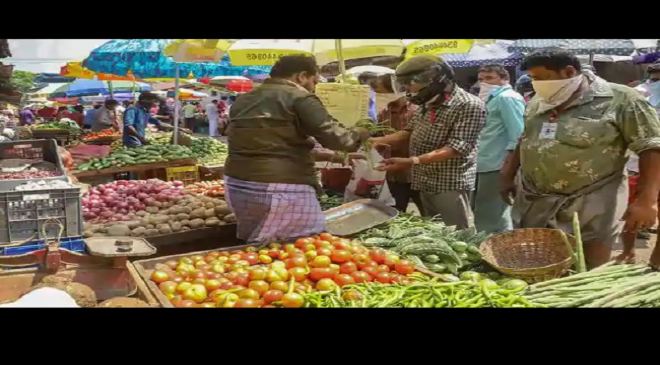There is a hope that inflation in food articles is expected to rationalize by September/October 2024 on the back of a prediction of a normal monsoon, though the uneven distribution of rainfall is still posing a risk.
While India’s wholesale price index (WPI)-based inflation accelerated for the third consecutive month to 2.61 percent in May, primarily due to increase in prices of food articles, economists said that the outlook for inflation looks brightened due to anticipation of a normal monsoon. Sarbartho Mukherjee, Senior Associate Economist, CareEdge Ratings, said, “The outlook for food inflation has brightened due to anticipations of a normal monsoon, which is expected to bolster agricultural production. However, monitoring the monsoon’s temporal and spatial distribution is critical.”
Read More: Petrol, Diesel Price Today: Check Latest Fuel Prices In Your City On June 17
Earlier last week, data released by the Ministry of Commerce & Industry stated that WPI inflation rose to 2.61 per cent in May, primarily due to increase in prices of food articles, manufacturing of food products, crude petroleum and natural gas, mineral oils, and other manufacturing. In April, WPI inflation was at 1.26 per cent on increase in prices of food articles, electricity, crude petroleum & natural gas, manufacture of food products, other manufacturing, etc.
Inflation for food articles, according to the release, stood at 9.82 per cent in May as against 7.74 per cent in April. For the primary articles, the inflation rate came in at 7.20 per cent from 5.01 in April. The fuel and power inflation was at 1.35 per cent in May as compared to 1.38 per cent in April. Further, manufactured products inflation stood at 0.78 per cent.
Read More: Zomato In Final Talks To Buy Paytm’s Movie Ticketing, Events Business for Rs 1,500 Crore: Report
Per economists, while Brent crude prices have moderated in the past two months, the recent uptick in global commodity prices, especially industrial metal prices, warrants close monitoring as it can result in higher input costs. Since the end of March, industrial metal prices have risen by 9.3 per cent. Globally, food prices are also increasing, with the FAO Food Price Index rising for three consecutive months after moderating throughout CY 2023.
“The WPI rose to 2.6 per cent YoY in May, from 1.3 per cent YoY in April. The acceleration in YoY terms was due to adverse base effects. The price momentum in May was mostly driven by food and manufactured products. We note that sequentially, the price index for manufacturing (which has the highest weight in the WPI, at 64 per cent), has risen sequentially for the fourth straight month, indicating that firms’ input costs are rising, resulting in the sub-index rising 0.5 per cent YoY in May, after remaining in deflation for 14 months,” said Shreya Sodhani, Regional Economist, Barclays, while adding that the headline print was below consensus and Barclays’ estimate, which came from a MoM decline in energy prices.
Read More: Gold Rates Today: Check Top City Wise Gold Prices In India On 17th June, 2024
Suman Chowdhury, Chief Economist and Head-Research, Acuité Ratings & Research, added, “The WPI print has more than doubled to 2.61 per cent YoY in May’24 from 1.26 per cent YoY in Apr’24. Clearly, a gradual hardening in global commodity prices, the increase in logistics costs due to geo-political risks, seasonal rise in food prices and strong industrial activity in India are driving the uptick in wholesale prices.” He added that the pressure in WPI inflation can also partly percolate to the headline CPI inflation and make its moderation journey towards 4.45 per cent difficult.
However, there is a hope that inflation in food articles is expected to rationalize by September/October 2024 on the back of a prediction of a normal monsoon, though the uneven distribution of rainfall is still posing a risk. Aditi Nayar, Chief Economist, Head of Research and Outreach, ICRA Ltd, said, “The progress of the southwest monsoon has been quite uneven so far up to June 13, 2024, with excess rainfall in the Southern region, and a deficient rainfall in Northwest and East and Northeast India, amid heatwave conditions in these regions. Well distributed rainfall would be crucial to support the timely onset of kharif sowing across states, as well as replenish the reservoir levels, which are essential to keep a check on food inflation. In addition, MSPs for the kharif crops are awaited, which would also influence the sowing trends.” With the YoY prints of a majority of food items, including edible oils, cereals, and few vegetables have trended lower in June 2024 vis-à-vis May 2024, ICRA maintained that the WPI food inflation is likely to display some softening in June 2024.
Furthermore, global commodity prices, including those for the Indian basket of crude oil have also retreated on a MoM basis in June 2024 so far. This, ICRA added, would help contain the uptick in the YoY WPI inflation print in the month, countering the adverse base. Overall, ICRA expects the headline WPI inflation to inch up modestly to ~3.0 per cent in June 2024.
Sanjeev Agrawal, President, PHD Chamber of Commerce and Industry, added, “Going ahead, inflation in the food articles is expected to rationalize by September/October 2024 as many of the kharif crops will be entering the mandis and supplementing the existing supply on the back of government strengthening the supply chains and expectation of above normal southwest monsoon.”





































